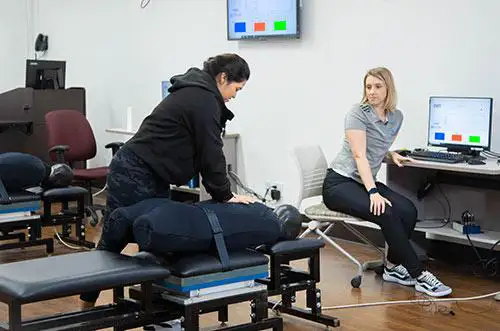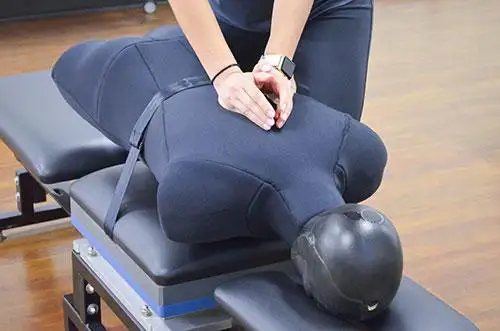Doctor of Chiropractic
Program Details
SCU’s Doctor of Chiropractic program teaches an evidence-based, whole-person approach to practice. Our University-wide commitment to Interprofessional Education sets our program apart, and our innovative curriculum is built around the educational needs of the modern doctor of chiropractic who works collaboratively with other healthcare professionals and integrates a wide range of therapeutic approaches and interventions to improve the health of their patients.
Each Year at a Glance
Year 1 The Foundation
Concentrate on the foundational health sciences to understand the human body. Learn how the anatomy, physiology, biochemistry, and pathology inform the health and function of human tissues and organs. Begin hands-on experience in Chiropractic skills courses in your first term.
Year 2 Focus on Clinical Sciences
Learn how to identify the signs and symptoms of health problems using orthopedic, neurology, imaging, and lab diagnosis. Make an evidence-based diagnosis and management plan to support patient care. Go more in-depth and gain critical exposure to other schools of thought with interprofessional education courses.
Year 3 Putting It All Together
Put foundational health and clinical science knowledge to work as you treat patients under the supervision of licensed doctors and apply your collaborative skills with other healthcare professions. Be prepared to lead in today’s evolving healthcare environment.
Specializations
You may select elective credits from a list of approximately 60 courses. You have the option to choose any combination of courses you like, or to pursue an emphasis or specialized series.
- Sports Medicine Emphasis
- Eastern Medicine Emphasis
- Interprofessional Education and Practice Emphasis
- Integrative Health Promotion Series
- Sports Medicine Series
- Functional Medicine Series
- Business Series
- Clinical Education Series
- Expanded Clinic Series
- Diagnostic Imaging Series
- A La Carte Courses
Elevate Your Skills With a Sports Medicine Emphasis Certificate
Sports Medicine Chiropractors help people of all activity levels, from high-caliber athletes, recreational athletes, and those seeking to feel great engaging in daily activities, to optimize their athletic performance and move toward optimal functioning. Work with elite faculty like Dr. Joe Horrigan, Conditioning Coach for the LA Kings NHL team. Learn More…
Complete Your Bachelor’s While Earning Your Doctor of Chiropractic – No Extra Time Required
SCU offers an embedded bachelor’s degree option for students pursuing the Doctor of Chiropractic (DC). This option allows students who have not yet completed a bachelor’s degree to earn a Bachelor of Science in Health Sciences (BSHS) while completing the DC program. The curriculum is designed so that many courses count toward both degrees, enabling students to complete their bachelor’s and doctoral requirements within the same timeline.
Enhanced Licensure Eligibility
The Bachelor of Science in Health Sciences component ensures eligibility for licensure in all jurisdictions*, including states that require a baccalaureate degree for chiropractic practice. This comprehensive preparation provides graduates with maximum flexibility in choosing their practice location. Note: California does not require a bachelor’s degree for licensure. *Exception: The states of RI and WV currently require the completion of a bachelor’s degree prior to starting a chiropractic program.
Turn 48 Credits Into Your Pathway to a Doctor of Chiropractic Degree
With 48 or more credit hours, you can enter the Bachelor of Science in Health Sciences Chiropractic Sciences concentration. This program fulfills the admissions requirements for the doctoral program and allows you to save time on your journey toward earning the degree. Learn More.
Dual Doctorate Degree in Acupuncture and Chinese Herbal Medicine Pathway
For students seeking career flexibility and increased earning potential, SCU offers a combined Doctor of Chiropractic (DC) and Doctor of Acupuncture and Chinese Herbal Medicine (DAcCHM) pathway. This dual-degree program allows chiropractors to broaden their practice and enhance their revenue opportunities.
By pursuing both degrees, students can complete their studies in as little as 5 years and 4 months, reducing their time to completion by up to 16 months and saving up to $30,750 in tuition.
How does it work?
Students begin with the Doctor of Chiropractic program and include Acupuncture and Chinese Herbal Medicine courses as part of their DC Selectives. These courses are applicable to the DAcCHM degree. One term before starting DC clinical training, students apply for admission to the DAcCHM program, transferring approximately 40% of the DAcCHM credits earned. During the DC clinical training phase, students will simultaneously begin their DAcCHM program. After completing the DC degree, students will need just two additional years to finish the DAcCHM degree, allowing them to earn both doctoral degrees in as little as 5 years and 4 months.
How does it save time and cost?
By enrolling in the dual pathway, students can complete two professional doctoral degrees in as little as 5 years and 4 months, compared to the 7 years typically required if pursuing the degrees separately. SCU’s innovative approach allows DC students to start the DAcCHM program during their DC clinical studies, usually around the middle of the third year (Term 8). Students can receive up to 75 transfer credits from their DC coursework (53 credits) and Selectives (22 credits) towards the DAcCHM program, covering nearly 40% of the DAcCHM curriculum. This integration can result in savings of up to $30,750 in tuition.
While the DAcCHM is the recommended dual-degree pathway, students may opt to apply to the Master of Acupuncture and Chinese Herbal Medicine (MAcCHM) program instead, which is one term shorter, potentially reducing completion time by up to four months. Financial aid and scholarships are typically available for students enrolled in both programs.
What are the admissions requirements?
Students accepted into the Doctor of Chiropractic program need to apply to the Doctor of Acupuncture and Chinese Herbal Medicine program one term before they start clinical education. Applicants must meet the admissions requirements for the DAcCHM program.
Dedicated Academic Advising, Mentorship, and Tutoring Support
DC students have access to the LACC Academic Advising Office (AAO), which offers both one-on-one advising and group mentoring. The AAO’s mission is to go beyond basic course planning to help students set and reach their academic and professional goals while fostering a collaborative learning environment.
The AAO’s advising approach provides accurate, timely guidance on policies and procedures and supports each student’s academic, professional, and personal growth. Following a learner-centered philosophy, the AAO encourages active student engagement, connects students with resources such as SCU Tutoring Services, and helps build strong relationships with faculty, staff, and peers.
Program Learning Outcomes
- Assessment and Diagnosis: The graduate will be able to utilize appropriate clinical reasoning skills to accurately assess and diagnose patient conditions.
- Management Plan: The graduate will be able to critically appraise and integrate evidence-based research in developing, implementing, and monitoring an integrative whole person care plan.
- Health Promotion and Disease Prevention: The graduate will be able to apply epidemiological principles to promote health and prevent disease.
- Communication and Record Keeping: The graduate will be able to communicate professionally.
- Professional Ethics and Jurisprudence: The graduate will be able to exhibit legal and ethical behavior as a health care professional.
- Cultural Competency: The graduate will be able to integrate the social, cultural, and linguistic needs of diverse patient populations to provide whole-person care and reduce disparities in healthcare delivery.
- Chiropractic Manipulation: The graduate will be able to deliver appropriate, safe, and effective chiropractic manipulation.
- Inter-professional Collaboration: The graduate will have the skills to coordinate and collaborate with other healthcare professionals as a member of an inter-professional healthcare team to plan and manage patient-centered care.
Mission
Los Angeles College of Chiropractic prepares students to become compassionate, evidence-informed chiropractors who improve lives through an integrative, person-centered, outcome-focused approach to health and healing.
Force Sensing Table Technology (FSTT) Laboratory
The Force Sensing Table Technology Lab helps enhance student training, expedite assessment of manual therapy skills, and improve treatment for patients. SCU’s FSTT Lab improves clinician training by providing instant analytical information to students, something that cannot be directly measured from human patients.
The force sensing technology is built into the tables, allowing students to practice adjustments on people, or practice on mannequins.
- The FSTTs pick up the adjustment information and display feedback on a monitor so students can see in real-time, what their adjustments look like in graphical form.
- The mannequins simulate the structure of the human spine, soft tissue and have flexible necks for practicing, training, and evaluation of manual therapy skills.
The FSTTs are tools for chiropractic students to take advantage of and learn early on, where they need to develop. The FSTT shows students where they excel, and where they need to focus more attention. It shows them their speed, pre-load tension, if they recoil (meaning lose pre-adjustive tension) during the thrust, how much force they are delivering, their line of drive, among several other types of helpful feedback. The FSTT Lab helps students create good habits early on in their adjusting careers, which will make them better adjusters, as future chiropractors. This tool has the ability to give students the confidence they need to deliver the best care, through proper, effective adjustments.


